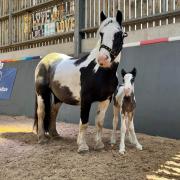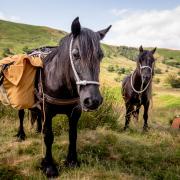Clitheroe’s Inger Vandyke doesn’t just travel the world taking stunning pictures of threatened species and communities facing destruction – she also provides practical help. She spoke to Irene Amiet/

Photographer Inger Vandyke travels the world seeking out remote communities and rare animals. As an expedition leader and member of the Royal Geographic Society, her home in Clitheroe can often be a quick pitstop to recharge her batteries and pick up fresh clothes.
Yet, those exotic destinations – up to 18 in a single year – haven’t blinded her to the attractions of the Ribble Valley. ‘Believe it or not, I love the chameleon weather patterns and their effect on Pendle Hill,’ she says. ‘I can wake up in the morning to find Pendle covered in snow and by the end of the day it has melted and the sunset sky has blushed pink and you find yourself wondering how amazing it is that you can experience two incredible scenes in one day.’
Inger was born in Queensland, Australia, but when she moved to Lancashire it was something of a homecoming as her mother, who emigrated in her teens, was born in Fleetwood. No surprise then that Inger spent much of her childhood on her parents’ fishing trawler.
It infused her with a real sense of adventure. After earning a diploma in photojournalism, she volunteered to work with seabirds in Antarctica and supplemented that conservation project with her own images.

The first time she sent an article and photos to an editor she crossed her fingers. Next thing she knew he work made the cover of an Australian magazine.
‘I used to struggle with insecurity. I still do,’ Inger says over coffee at the Clitheroe Emporium. ‘To think it’s never quite good enough drives me to constantly be better.’ Inger’s photos have received up to eight million hits on the internet and she’s in over 30 publications worldwide. It’s safe to say she’s good enough.
It’s not only the quality of her photos. They often celebrate strong colours; a Steller’s sea-eagle’s yellow bill against cobalt blue skies in Japan or a tribal outfit of a girl in Namibia. They also convey an immediacy and an with her subjects.
She remembers a trek to the Indian mountain state of Ladakh to track one of the most elusive predators in the world, the snow leopard. Night temperatures plummeted to -20, her camera’s sensor was frozen to her skin and her fingers kept bleeding as gloves would prevent her from operating her kit. Physical sacrifices she shrugs off. ‘There was no time to deal with protective gear. As soon as the cat was there, she was gone.’ Inger was the first female photographer to capture a snow-leopard in the wild.

After years freelancing, Inger is now general manager of Wild Images, a Lancashire-based company specialising in photographic tours. Her partner, Mark Beaman, owns the business which, together with its sister company Bird Quest Images, has been going for eight years.
The Ladakh trip has become a staple in the company’s tours. Guests become involved in “citizen’s science”, supplying local conservation efforts with crucial data. ‘Eco-tourism and education should always create a symbiosis,’ says Inger. The former is a welcome income generator for the local people, giving them the financial freedom to focus on their natural heritage.
The people of Ladakh now need fewer sheep to support themselves, which allows for more wild cats, which in turn is great for visitors. ‘The younger generation won’t stand for killing leopards anymore, while their parents would have rid themselves of threats to their livestock,’ says Inger, whose company sponsored livestock protective enclosures as well as bringing tourists.
In between trips Inger gives presentations of her work in a field that is still male dominated. Keen to encourage young photographers, Inger enjoyed being a guest at Stonyhurst College last year. ‘Why pull up the ladder when you’ve made it to the top? I appreciated any legs-up when I was younger, as would anyone. It’s a tough industry, but if you have a talent, I say find your way and keep going.’

Documenting indigenous tribes is one of her biggest passions and communicating with a subject is key. ‘A portrait shouldn’t be a pretty picture, but a look at someone’s life. I always ask permission before shooting. Respect should underpin my work at all times.’
Younger generations feel embarrassed to wear traditional clothing, or seek their fortunes away from their native lands where life is easier. Those are reasons Inger has brought to life projects such as support for women’s alliances in rural and tribal communities, to help address issues like sustainable agriculture and small business skills. She has a deep respect for indigenous tribes who try to hold on to their cultural identity while embracing modernisation. ‘We all can learn from each other, but we shouldn’t all look and act the same and grow into a big Western monoculture. It makes me sad to see how people become disconnected,’ says Inger. She’s seen communities and whole sub-cultures disappear in the suburbs of Delhi, displaced by construction and modernisation.
Because of her vast library of tribal photographs, Inger was asked to take part in “Vanishing Earth”, a project that documents and monitors environmental impact on our planet’s diversity. ‘We know how animals are going extinct. But tribes are also swallowed up in the name of education,’ says Inger.
How have the tribes of the Ribble Valley taken to her? ‘The people I’ve met in Clitheroe have embraced my Aussie accent with a healthy dose of friendship and good humour, especially when they see me buying up Vegemite at the supermarket.

‘That’s an absolute sign that you can take the girl out of Australia, but you can’t take Australia out of the girl.’




























